Luxury palace hotels in India
Live like royalty in this vibrant former Indian palace that counts Jackie Kennedy and Queen Elizabeth II among its previous guests.

Call me shallow, but staying at a 1920s Art Deco palace owned by a dashing young maharaja, who captains the national polo team and occasionally models on the catwalks of Milan, feels like the last word in Indian hotel luxury. Princely palace hotels are nothing unusual in India. Many of the subcontinent’s most exotic properties belong, or belonged to, royalty. Each promises a unique stay but none has quite the whimsy or exuberance of Rajmahal Palace, a 13-suite folly in the UNESCO-listed city of Jaipur.
Built in 1729 by Maharaja Sawai Jai Singh II as a gift to his wife, and operated as a hotel since the late ’70s, Rajmahal Palace was given a flamboyant makeover in 2015 by mod-Mughal design guru Adil Ahmad. Inspired by classical patterns he found in the royal family’s archives, Ahmad designed 48 indigenous wallpapers that adorn every upright surface. He then added an excess of velvet and leather, gilt and ormolu, family photos, art and heirlooms to create one of India’s most unforgettable addresses.
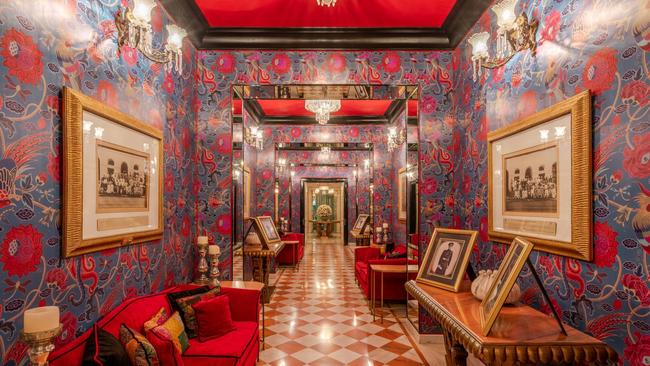
Last year, Rajmahal joined the portfolio of RAAS, the hotel group behind such singular hotels as RAAS Jodhpur, a converted 18th-century haveli at the base of Mehrangarh Fort, where regulars assure me both service and food standards have improved under the new management.
The main entrance to Rajmahal is via a curving avenue flanked by frangipani and hedged with jasmine. Guests pass under a ceremonial archway where one and a quarter gaily striped flags fly overhead. This is to show that Jaipur’s nominal royal family is sawai, or “a quarter above their contemporaries”. It was a title bestowed on Jai Singh II by the Emperor Aurangzeb, after the maharaja’s victory in battle.

I’m greeted on arrival by operations manager Saurajit Nanda with a welcome drink of Pink Spritz, rose-infused wine blended with soda, mint and fruits and served in a stemmed crystal glass. Previous palace guests Jackie Kennedy and Queen Elizabeth II gaze out from monochrome photos as I nibble roasted cashews under a 24-arm chandelier in the turquoise leathered Polo Bar. (“Many of the international jet-set have enjoyed the wondrous hospitality within these palace walls,” according to my room compendium.)
Jaipur is famously known as the pink city after being painted that colour for the state visit of Albert, Prince of Wales, in 1876. Rajmahal embraces the theme with gusto, nowhere more so than in the main restaurant, 51 Shades of Pink. Here everything is indeed pink, from the crockery and air conditioners to the waiters’ kurta pyjamas and turbans, the bowls of rose petals and the vividly papered walls.

The restaurant serves very good Indian food, including tandoor-roasted chicken, fish and lamb and various curries from ginger-rich palak paneer (spinach and cheese) to Old Delhi-style murgh (chicken) korma. Dining here is hyper-sensory, the crowning touch a central display of tuberose stems that make the restaurant smell like paradise. As Nanda says, “If you have a palace property, the only thing that complements it is flowers.” (To that fragrant end, palace interiors are scented with Madurai jasmine, thanks to discreetly placed diffusers.)
Rajmahal’s other signature colour is the green of its extensive English-style grounds. The two blend brilliantly one morning at breakfast when pink-and-green ring-necked parakeets suddenly explode in the air above the emerald lawns and rosy palace.
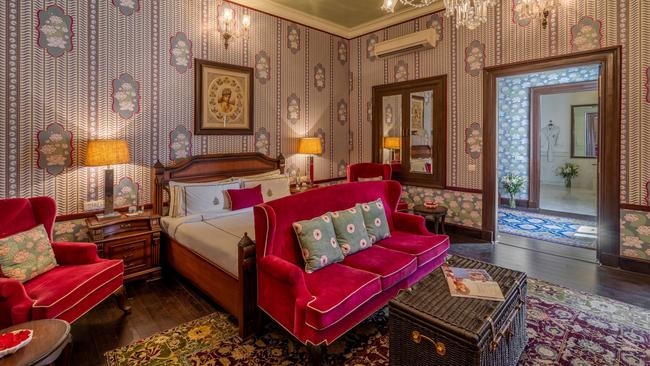
I’m staying in the lavish Yuvraj Suite (though lavish is a very relative concept here) tucked behind a mirrored door in the Chinoiserie-patterned corridor between reception and the restaurants. Central but oh-so-discreet. The bathroom is clad so extensively with marble that human skin will never touch anything else in there. The bedroom is a vision in cherry-red velvet and pure white bedlinen embroidered with gold thread and the royal crest. Wallpapers and carpets are lotus themed in vivid tones of navy, orange and crimson. But my most treasured indulgence is the pot of masala chai delivered to my bed each morning by waiters dressed toes-to-turban in pink, like human flamingos.
The hotel’s inventory includes four palace rooms, two palace suites, two royal suites (one named after Jackie Kennedy, the other after Dickie Mountbatten), the QEII suite (she stayed here in 1961) and the Maharaja and Maharani suites. The former is a 260sq m marvel accessed via a vestibule striped in the colours of the royal flag, its bedroom encased in black marble and bathroom crusted with floral mosaics. The latter, its entrance framed by pink marble columns, features floors of green Udaipur marble and balcony doors opening to a movie-star staircase and private pool.
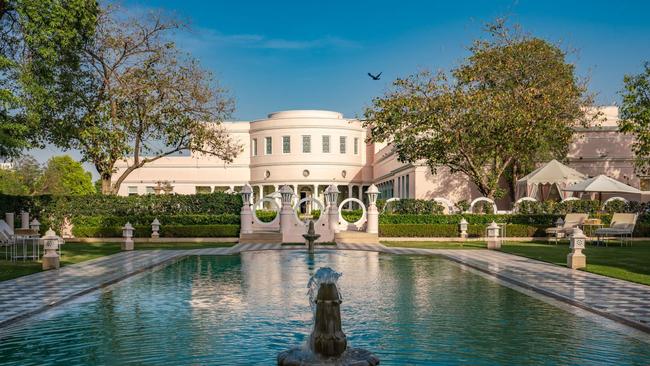
Elsewhere in this urban oasis there is a one-room spa in the neighbouring Art Deco apartment (also home to two entry-level rooms), a pink-and-white pool book-ended by fountains and a luminous conservatory restaurant called The Colonnade. There are also four framed carpets presented to the Jaipur royals by the Shah of Iran, and a grand piano beneath the main staircase that was a gift from the late Queen Elizabeth. But the most opulent space is the ballroom-sized Durbar Hall with its giant oil paintings, gilt armchairs and richly layered paintwork and fabrics. It’s currently being transformed into a house cocktail bar, complete with central servery in pink marble.
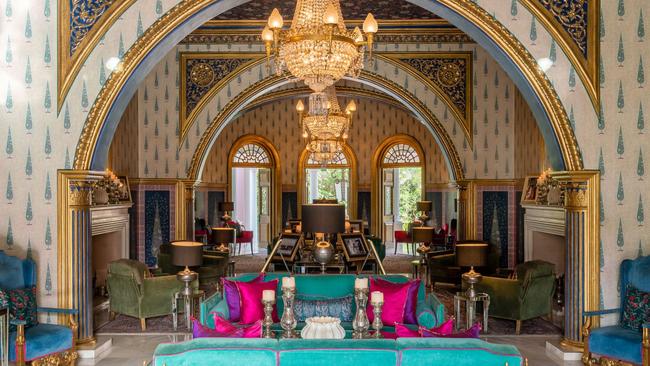
The hotel is conveniently within 20 minutes of key Jaipur attractions such as City Palace, Hawa Mahal, the flower markets and the professional turban-tying services of Johari Bazaar. Hotel staff are mines of information when it comes to the best city shopping (textiles, jewellery, gems, and interiors). They can also book guided tours of forts and museums, printing workshops, even “an introduction to polo”.
On my last night a group of us has dinner on the upper lawn. The faint hum of the city is camouflaged by cool jazz as we dine on Kashmiri morels lacquered with gold leaf, a yoghurty goat stew recipe “from an undivided India”, and creamy pistachio kulfi. Poised pink-clad waiters glide about lit only by lanterns, of which many dozens burn bright all around us. I’ve stayed at many hotels (palace and otherwise) in Rajasthan over the years but can’t remember an evening quite as magical as this.
In the know
Jaipur is one hour by plane or about five hours by road from Delhi; a new expressway nearing completion should halve that driving time. Rooms at Rajmahal Palace Hotel from INR35,000 ($600) a night, including breakfast. Qantas recently introduced direct weekly services between Sydney and Bengaluru to complement its Melbourne-Delhi direct flights. Onward connections to Jaipur are easy thanks to the airline’s codeshare pact with domestic carrier IndiGo.
-
More palatial properties in India
Phool Mahal Palace
The great gift of India, especially Rajasthan, is that so many former princely palaces are now run as hotels, running the gamut from great to grungy. The 19th century Phool Mahal, or Flower Palace, sits somewhere in the middle of them. Arranged beside a lake in Kishangarh, a marble quarrying city about two hours’ drive west of Jaipur, the 21 rooms of this Art Deco-meets-Mughal pile feature handpainted murals and scalloped niches framing serene water views. Guests can picnic in waterfront parklands, explore the imposing 17th-century fort that looms behind the palace, and step back in time through Madan Pol gate into the friendly, fascinating old city with its 100-plus havelis (mansions) all in various states of repair. Phool Mahal is most fetching at dawn when it’s mirrored in the lake’s surface like a fairytale drawing come to life.
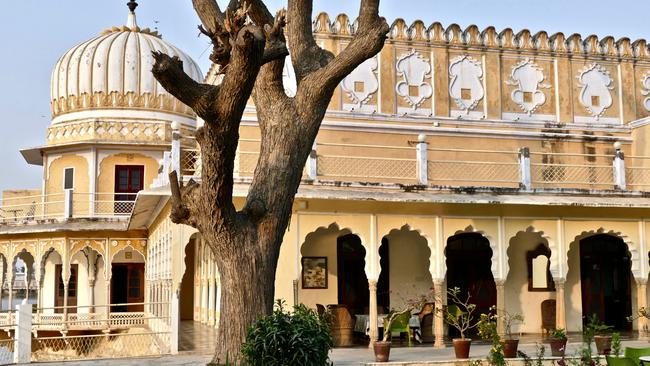
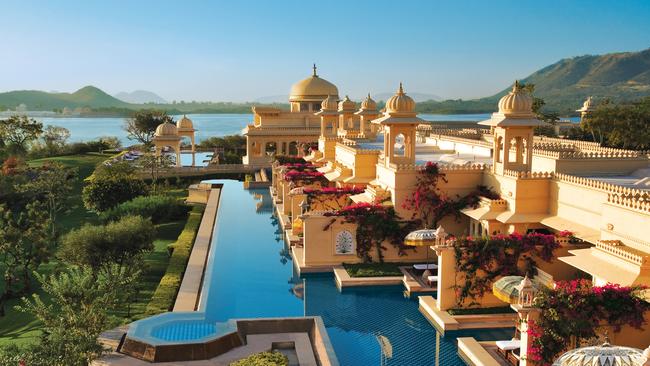
Udaivilas Resort
The 87-room Udaivilas, arrayed over 30ha of former hunting grounds on the shores of Lake Pichola, is proof romance is not dead. This marbled mirage was only completed in 2001 but its extravagance and meticulous craftsmanship recapture the golden age of Mughal India. Behold the domes (all 34, to be precise), the chhatri pavilions, the fortified walls and the frescoed interiors glittering with Belgian crystal chandeliers. Some guestrooms and suites come with pools or marvellous lake views, others with perfumed terraces overlooking the grounds where peacocks roam free beneath canopies of pink catalpa. Dining is always an event, whether by candlelight or sunlight on Chandni’s lakeside terrace or beneath the golden dome of Udaimahal, the hotel’s signature restaurant serving royal thalis and authentic Lucknow biryanis. Service by Oberoi-trained staff is enthusiastic, smart and always a delight. Small wonder that Udaivilas ranks regularly among the world’s finest hotels.

Bissau Palace
I love this ramshackle estate for its unlikely location in the heart of Jaipur’s old city and for the faded allure of its 51 guestrooms. But ask to see a few before committing to one, as despite the grandeur of its architecture, Bissau Palace is three-star at best but brimming with charm. It has, as the website declares, an “atmosphere pregnant with intrigue, excitement, tragedy” so is perfect for more adventurous guests (the Old City is a maze of wonders) or fans of the Wes Anderson aesthetic. Interiors are lavishly frescoed and furnished with heirlooms and military bling from the collection of the noble Shekhawati family who own the hotel. The catering is average but convenient for breakfast, either poolside or in the dazzling sheesh mahal or mirror palace, but as Jaipur is one of India’s most cosmopolitan food cities, it’s much wiser to take all other meals outside the property.
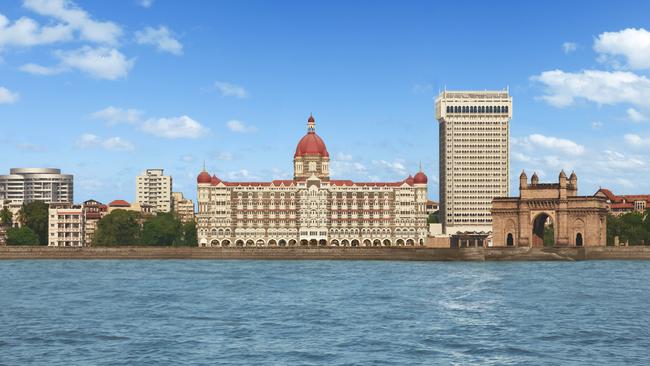
Taj Mahal Palace Hotel
The late historian Sharada Dwivedi once told me she never tired of Mumbai’s seafront Taj Mahal Palace hotel because, “It represents the hopes and aspirations of the people. I feel it represents the spirit of Bombay more than anything else in the city.” I couldn’t agree more. This six-storey, neo-Gothic city symbol has towered above Mumbai’s back bay since 1903. In the years since it has become the touchstone of the city, and the place that every Mumbaikar aspires to one day earn the right to enter. Guests staying in one of the 285 rooms and suites in the heritage palace building have dress-circle access to this exhilarating metropolis; the galleries, gastronomy and Gothic architecture of South Mumbai lie just outside the porte-cochere. Between outings the Taj is always a calm and welcome oasis of palm-fringed pool, perfumed corridors and excellent restaurants.
Kendall Hill was a guest of Banyan Tours.

To join the conversation, please log in. Don't have an account? Register
Join the conversation, you are commenting as Logout